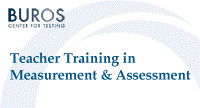Buros-Nebraska Series on Measurement and Testing

Teacher Training in Measurement and Assessment Skills
Date of this Version
1993
Document Type
Article
Citation
Published in Teacher Training in Measurement and Assessment Skills, edited by Steven L. Wise (Lincoln, NE: Buros Institute of Mental Measurements, University of Nebraska–Lincoln, 1993).
Abstract
Public education, and its assessment practices, have evolved from beliefs about how the world operates that are equivalent to the flat-earth theory. As long as the assessment of students is designed to fit obsolete "truths" about knowledge, learning, the mind, and human organizations, the roles and responsibilities of teachers in conducting such assessments, their purposes for doing so, and their preparation for fulfilling them will be likewise obsolete.
The following self-assessment (Figure 1) meets only one of fellow presenter H. D. Hoover's criteria for tests. It has not been checked for validity, reliability, objectivity, or fairness. It is, however, feasible. Thus, I invite you to examine some of your beliefs. Indicate the degree to which you agree or disagree with each of these statements.
I start with this examination of beliefs because neuroscientists tell us that believing is seeing. Their work expands the observations originally made by Kuhn in 1962 (Kuhn, 1970) that the paradigms governing scientists' work frequently prevent them from perceiving data that do not fit their particular structure of reality. What we believe about how the world works dictates what we are able to perceive in that world. Our beliefs, attitudes, and assumptions comprise our world view--the lenses through which we perceive and understand the world. William Barrett, describing the futility of the philosopher who professed to make a really fresh start in his discipline, points out, "Alas, he is found to carry in his intellectual baggage assumptions unsuspected by himself, as a consequence of which his data became selective and screened. He cannot see the glasses through which he is seeing" (1987, p. 36). And, what has this to do with the title of this chapter?
Teachers' lenses, or world view, inform their purpose in assessing students and that purpose dictates their roles and responsibilities. That purpose and its related roles and responsibilities are also focused by the world views of school administrators, boards of education, teacher educators, legislators, education department officials, researchers, test developers, and the public.
I intend to demonstrate how our beliefs define the current world of education and that corner of the education world we call "assessment." And how a different set of beliefs--or paradigm lenses--could reveal an entirely different world.
I will share a story told by psychologist Jean Houston (1982) to illustrate what I mean by a world view and by my theme "believing is seeing." She tells of a tribe in the Kalahari who believe that the world ends just beyond their local village boundaries.


Comments
Copyright © 1993 by Buros Institute of Mental Measurements. Digital edition copyright © 2012 Buros Center for Testing. This book may be downloaded, saved, and printed by an individual for their own use. No part of this book may be re-published, re-posted, or redistributed without written permission of the holder of copyright.